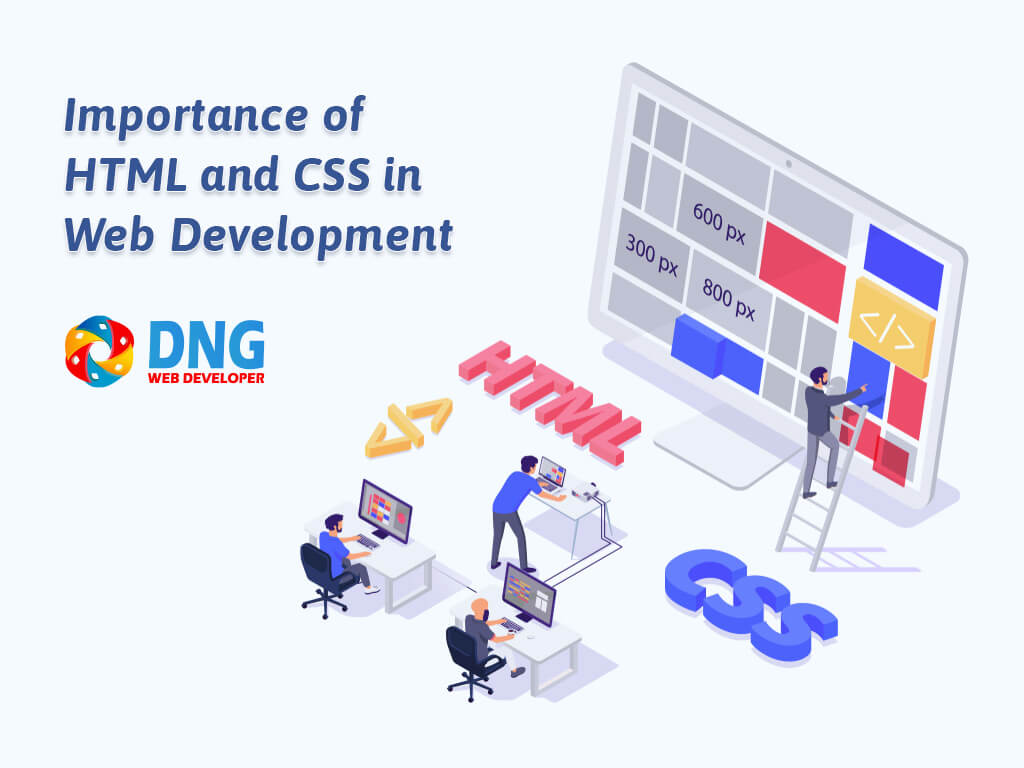HTML and CSS in web development – HTML (Hypertext Markup Language) and CSS (Cascading Style Sheets) are two of the most important technologies for creating Web pages. HTML provides the page structure, while CSS provides the (visual and aural) layout for a variety of devices. HTML and CSS in web development, along with graphics and scripting, form the foundation of creating Web pages and Web Applications. Find out more below:

What is HTML?
HTML has been the industry standard for professional websites since the dawn of the internet. It stands for Hypertext Markup Language, and it can be extremely perplexing to someone unfamiliar with it. The language, or code, used to change and place text, graphics, frames, and other web page elements is known as HTML and CSS in Web development. Anyone can see the code used to design that website if they go to their web browser and select View, then Source.
HTML is not difficult to learn, according to those who have used it. A designer only needs to understand a few fundamental tags (codes) and they can create a simple webpage. You can accomplish more with a site if the HTML is more complicated.
The procedure has been simplified even more so that anyone, even those with no prior knowledge of HTML and CSS in web development, can construct their own website. WYSIWYG (What you see is what you get) editors are the most common. They let you to construct a webpage without having to know how to code, as the editor will figure out what HTML you require and do the task for you. Converting your manuscript to HTML and CSS in web development is now an option in certain software products. These are excellent resources for newcomers. Unfortunately, guessing what code you need can lead to design blunders and errors, which can lead to even more stress.
Advantages of HTML:
The fact that HTML is widely utilised is the first advantage. HTML is supported by all browsers. It’s simple to learn and utilise.
Importance of HTML:
HTML For Website Designing:
HTML stands for Hyper Text Markup Language, and it is a fundamental component of website development. HTML is a markup language used to create web develpment pages. Tags are used to represent HTML elements. Content components such as “header,” “title,” “paragraph,” “table,” and so on are identified by HTML tags. HTML tags are not displayed by browsers; instead, they are used to display the page’s content.
HTML5 is the most recent version of HTML. HTML5 is a collection of modern technologies such as HTML and XHTML that may be the most efficient approach to learn web design. XHTML is another choice, although it has stricter constraints. The majority of webpages on the WWW (World Wide Web) are created using HTML as the primary language. In comparison to other languages, HTML is simple to master.
HTML is authored using HTML elements, which are made up of tags surrounded in square brackets. The language used to generate a web page is HTML. It works like this: a browser is a piece of software that reads HTML. As a result, HTML is used for all Internet tasks and Web page design.

What is CSS
CSS is a more recent addition to the web design world, and it is less familiar to newcomers than HTML. CSS was developed to provide designers even more freedom and control over their work. Today, HTML and CSS in web development designers must create for more than one type of Internet browser, which can be difficult and time-consuming. When consumers create websites, this saves them time, effort, and, most likely, money. CSS also encourages designers to build style sheets, which saves time. This implies that when you make a modification to one page, it affects all of the others. This eliminates the need for multiple revisions for large, detailed websites.
Advantages of Cascading Style Sheet (CSS):
Saves time, improves page loading speed, device compatibility, repositioning ability, and helps search engines crawl your web pages better.
Importance of CSS:
Help web pages load faster:
CSS has an underappreciated but critical benefit of speeding up page loading times. CSS rules are downloaded once and cached so that all pages of a website can be loaded quickly. It improves the overall user experience by speeding up website navigation.
CSS is used by web developers because it is lighter than array layout, which uses a lot of bandwidth.
Compatible with multiple browsers:
All web browsers are compatible with CSS. As a result, all web browsers will display a CSS-based website in the same way.
Mobile-Friendly Web Pages:
Another key benefit of CSS is that it allows you to print user-friendly web pages. This means that web pages can be printed without difficulty. Colors, pictures, and other difficult-to-print objects can all be removed and printed with ease.
Customization:
Users can customise the web page using CSS sheets. CSS sheets are externally stored and allow the user to make modifications as needed. Users can define their own style sheets in a number of recent browsers. As a result, a user can quickly adjust the font’s attributes, for example.
User-friendly search engine:
CSS style sheets help websites appear more prominently in search engine results. Because it allows you to move items anywhere on the page, the user can begin projecting the main material so that web crawlers can quickly catch it. It also generates cleaner HTML and CSS in web development codes, lowering the amount of time Web Spider has to spend searching for meaningful content among the clutter.
Display options:
Another prevalent web design challenge is the growing requirement to make websites accessible via many media. CSS may assist you address this problem by allowing you to build different display styles for the same HTML page: for example, you can construct a distinct style sheet for printing or a mobile device.
Bandwidth reduction:
When you use CSS to isolate your website’s content from its design language, you can drastically minimise the size of your file transmission. Your CSS document will be stored outside of your website and will only be accessed once when a visitor requests it. When you design a website with tables, on the other hand, every page of your website is available at every visit. Your lower bandwidth needs will result in a faster load time and maybe lower web hosting expenses.
Conclusion:
HTML and CSS in web development – Anyone, just as anyone can learn a new language, can learn to code. In fact, programming is similar to speaking a foreign language, which is why they are referred to as programming languages. Each has its own set of rules and syntax that must be learned step by step. Those rules are ways for you to instruct your computer on what to do. In HTML and CSS in web development programming, they are methods of instructing your browsers on what to do. The goal of this post was to teach you the fundamentals of HTML, CSS,, in plain English.



